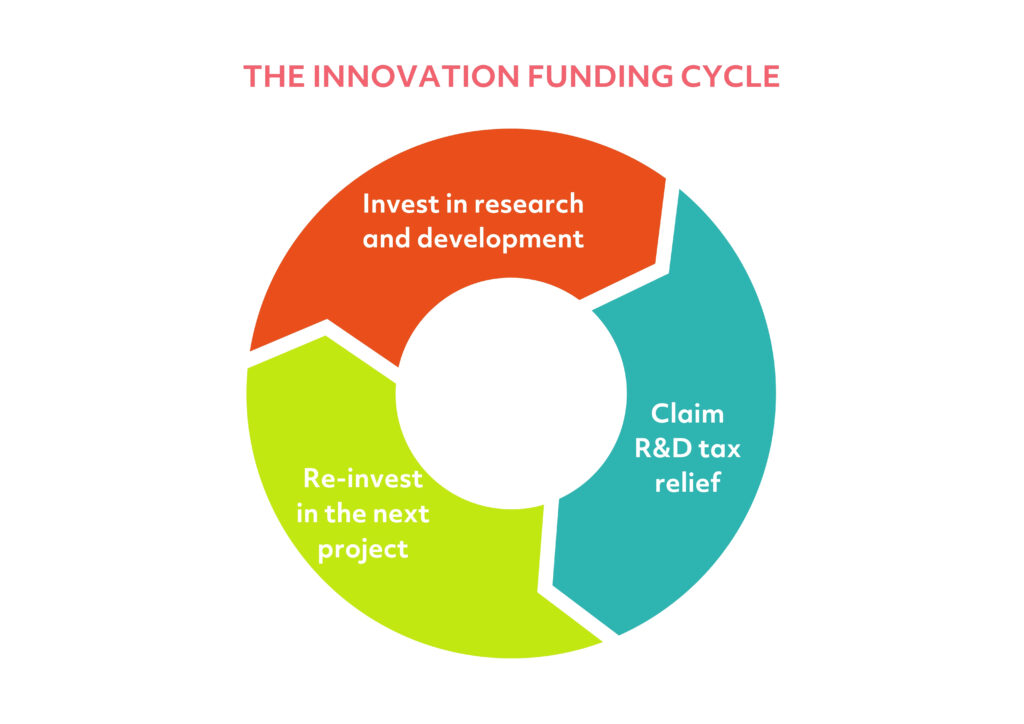Blog: Building your business with R&D tax credits
- R&D Tax Credits
- UK Business
- 5 Min Read
The government’s R&D tax credit scheme was created to help innovative companies do just that.
The scheme is used by thousands of UK companies to reward their efforts, so let’s look at what this tax relief is, how you access it and how it can help you build your business.
What are R&D tax credits?
Research and Development (R&D) tax credits allow businesses to claim back a proportion of research and development spend.
The relief is paid either as a saving on Corporation Tax, a cash credit, or a direct cash rebate and loss-making businesses can even use it to increase taxable losses.
As long as you’re a limited company in the UK, subject to Corporation Tax, and have spent money on research and development, then you pass the initial qualification test.
Costs that can be claimed for include:
- the development of new software and technology
- staffing including contractors and specialists
- consumables like water, fuel, power and materials used in the R&D
- and even R&D elements that were subcontracted
How R&D tax relief can help you build your business
With the average SME R&D claim being £63,000, research and development tax credits certainly help cover costs lost during the innovation phase. However, the savvier companies are using the relief to grow their business and develop a competitive edge by investing in further innovation.

The innovation funding cycle shows how investing more in R&D means bigger R&D projects, and therefore more tax relief – which is then available to invest again.
A consistent innovation funding cycle like this will help your business grow and even diversify since you don’t have to keep investing in the same type of R&D as you initially undertook.
How other companies have used the relief to grow
Specialist engineering company 5th Dimension Tooling Ltd put R&D at the heart of their business model.
This particular company commits to approximately 20 R&D projects per year and uses the funding from each project to invest in expanding into new services.
In the months after their first claim with MPA, 5th Dimension Tooling Ltd were able to launch two new services and are well on their way to even more growth in the future.
Read more about our work with 5th Dimension Tooling Ltd here.
We helped digital document solutions provide Doc-Works successfully claim for building a bespoke software solution for one of their clients.
Because the challenge was clear and the solution didn’t already exist, Doc-Works needed to undertake some research and development to deliver on the clients’ brief, making them the perfect candidate for claiming relief on the costs incurred at that point.
As a result of working through this challenging brief, Doc-Works now have a solution that can be used for other projects and are able to showcase a high-value customer within their portfolio of work that will help attract larger clients and projects moving forwards.
Read more about Doc-Works’ R&D claim here.
Ways to reinvest R&D tax relief
Businesses can ultimately choose to do what they wish with the funds received from R&D tax relief, but here are a few ideas to get you thinking:
- Invest in world-class talent
Many businesses use funds to grow their teams, attract sought-after candidates and build internal knowledge that helps them outperform competitors - Fund subcontractors
Businesses that aren’t ready to increase permanent headcount can instead invest in expert contractors or outsourcing - Purchase new equipment
Start-ups at or beyond the production stage can use funds to buy or rent the equipment necessary to speed up or increase production or service levels - Develop new processes
Other businesses can gain productivity advantages by developing new systems and processes that increase efficiency and profitability
How to claim
The claiming process isn’t as complicated as you think, especially if you work with an experienced advisor like MPA.
Here are our top tips for getting started, whether you want to claim yourself or you’re interested in working with us to do so.
- Establish eligibility
Find out if your business and projects meet HMRC’s eligibility criteria. There are two schemes dependent on the size of your company – SME or RDEC (Research and Development Expenditure Credit).
Use our R&D eligibility tool to start with or book a no obligation chat with one of our advisors.
- Calculate your qualifying expenditure
This is probably the most complicated part of filing a claim, and the reason why many aren’t as high value as they could be.
Aside from missing out on cash, mistakes when calculating qualifying expenditure can delay funding and even trigger a HMRC enquiry.
HMRC provides lots of advice on what you can claim against but the most fail-safe way to ensuring this is correct is to work with tax specialists who has practical knowledge of your sector.
Our advisors all come from the types of companies they work with so can quickly get to grips with your complex projects and businesses.
- Maximise your claim
As mentioned above it’s very common for people to miss costs that could have been claimed for, but this gets even more complicated when R&D was part-funded by grants or involve people placed on furlough.
There are also a few different options when it comes to calculating what you should apply for relief on – for example, it may be more beneficial to surrender losses, or carry them forward.
R&D tax specialists like ours are trained to analyse all parts of a claim and are experienced in providing the best advice for each client’s individual circumstances.
- Complete your application
Finally, you’ll need to complete your R&D tax credit application with a technical narrative and financial evidence.
The technical narrative is the most important part of your claim and where you’ll detail exactly how your R&D has advanced science and/or technology.
This requires industry knowledge – obtained either by completing the application yourself or working with an expert who knows your industry.
Make sure any tax relief advisor you work with can evidence successful claims and be sure that they understand your projects inside out in order to get this right.
If you’d like to unlock funds to really build your business, get in touch for a free consultation with MPA. And even if R&D tax relief isn’t for you we might be able to help you unlock other sources of funding and put you on the road to growth through innovation.

